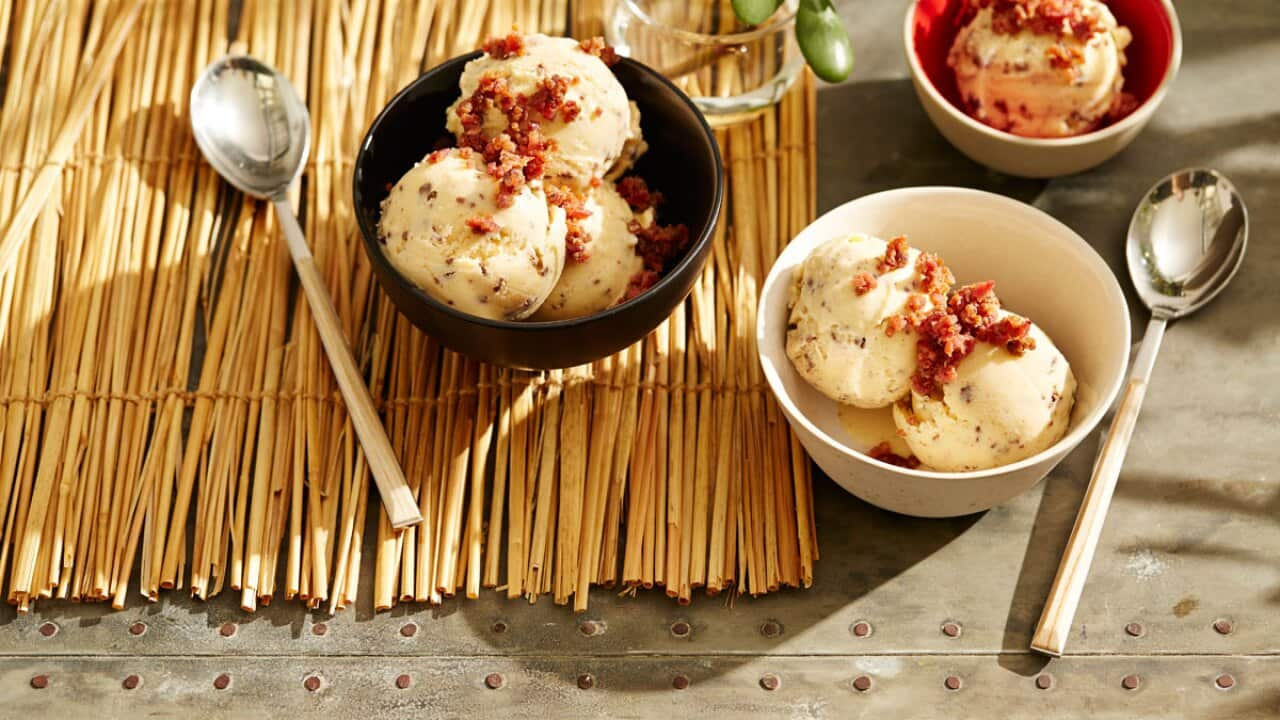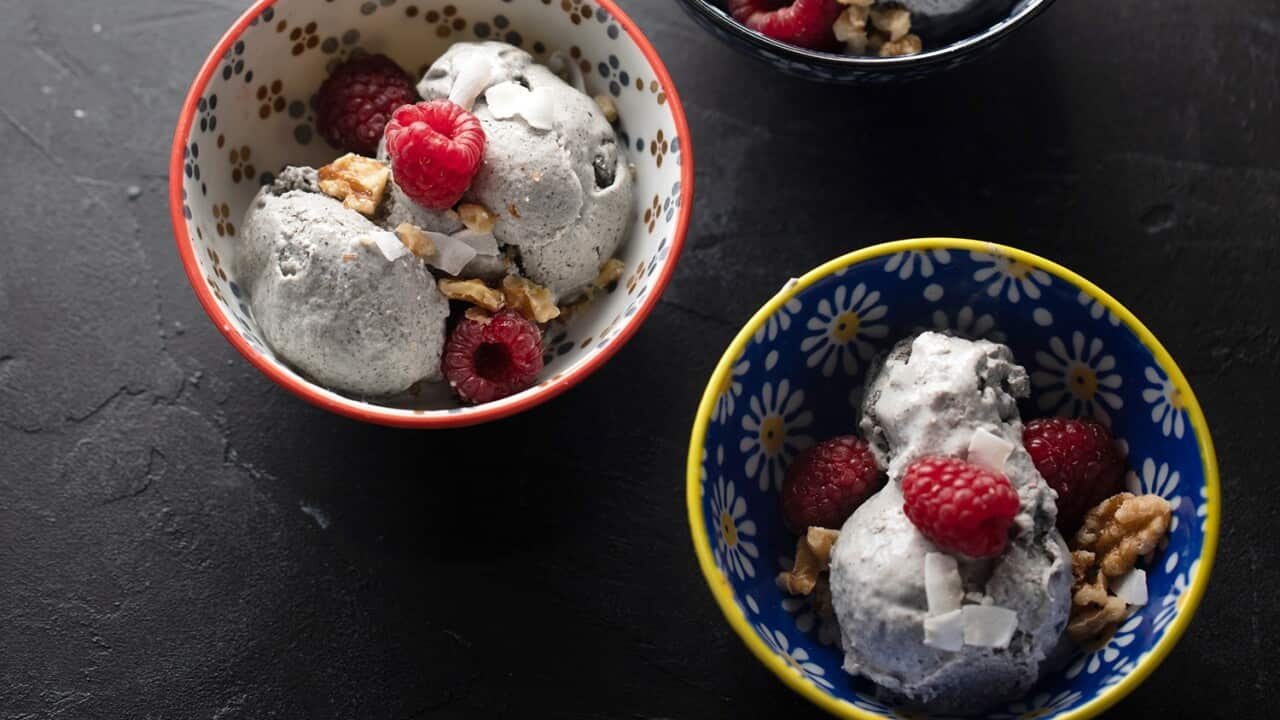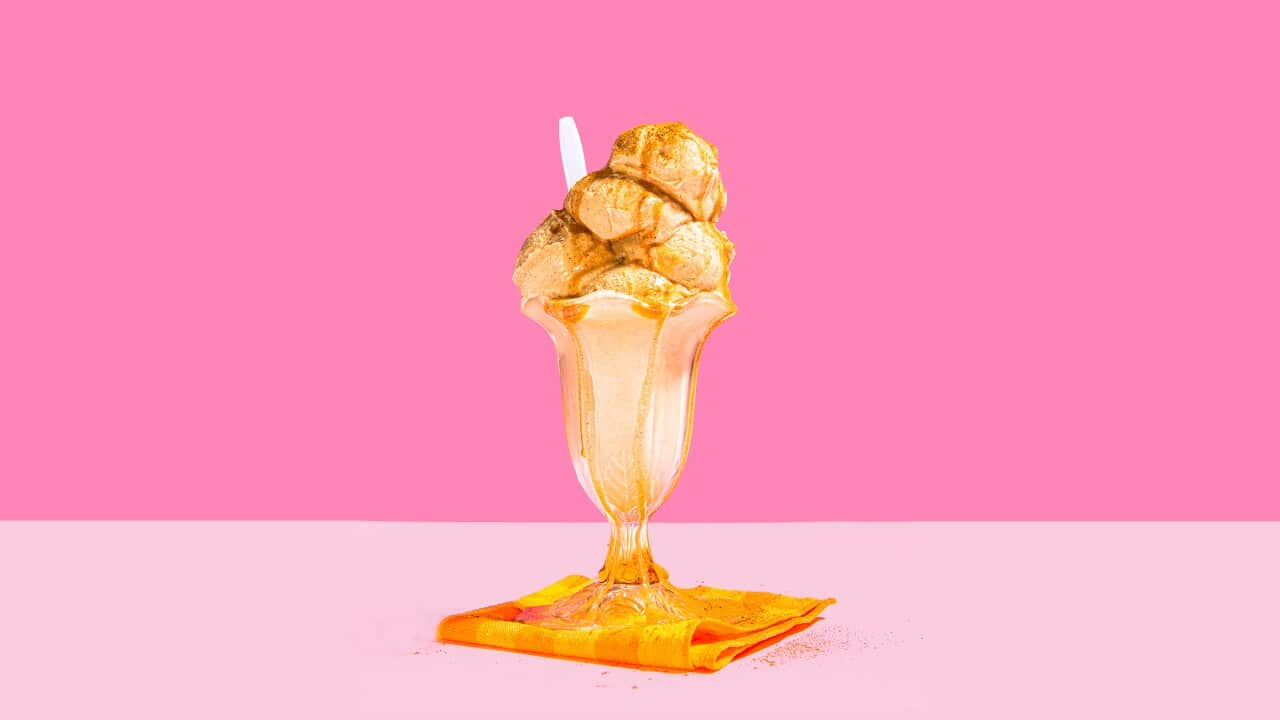Enjoying a scoop of ice cream on a warm day is like receiving a gift from the dessert gods. Loved by children and cherished by adults, ice cream has the ability to put a smile on your face like few other foods.
So why does ice cream taste so good? Accredited Practising Dietitian and nutritionist, Selin Aydan, says most full-fat ice creams start with a basic recipe that hits the human 'bliss spot' - combine fat (cream and milk) with sugar and you're onto a winner.
“These are the ingredients you need in a [dessert] to make you feel full and satisfied,” Aydan tells SBS.
“However, not all ice creams are equal. While we often assume that ice cream is just made of cream, milk and sugar, there are actually a lot of other things that go into most [commercially produced] dairy ice creams to create a fluffy texture.”
...not all ice creams are equal.
Chilling ice cream truths
Aydan explains that many commercially produced ice creams – purchased from supermarkets and takeaway shops (that do not market themselves as authentically homemade) – contain chemical , thickeners and flavourings.
Some also feature vegetable fats or oils to ‘fill’ the ice cream out. It’s a common way to add volume and creaminess to the texture of ice cream without hiking the cost.
The problem is that vegetable oil consumption can cause inflammation issues for some people. "Vegetable oils are high in omega-6 fats and if eaten in excess, they can actually inhibit the anti-inflammatory effects of other nutrients and promote diseases like heart disease, some cancers and even autoimmune disease."
Although it’s early days in terms of research, it’s also believed that emulsifiers and added to ice cream, like red or bubble gum blue, may cause various health issues.
"They can be harmful to the gut and may be associated with allergies over the long term. But the research that’s been done has been on animals and . So we don’t have enough information to conclude how it impacts human health. [But we are aware that some people] like children or individuals with irritable bowel syndrome may be more sensitive to these products. Consumption may result in flatulence, diarrhoea and abdominal pain in some.”
How about ‘healthy’ low calorie ice creams?
Some ‘healthy’ ice creams that claim to be better for you may fail to live up to their hype, Aydan advises.
Low-calorie ice cream that is low in sugar will normally contain artificial sweeteners like xylitol or stevia. “Kids and people who have IBS can be much more sensitive to artificial sweeteners. Consumption can cause negative consequences in some people.”
There are other unexpected additions in some low-fat, low-calorie ice creams. Antifreeze proteins have been used by some major companies to lower the cost of production.
Some gelati may also include corn-syrup and a paired ingredients list, which may contain anything from flavourings, artificial colours to preservatives.
One particular natural antifreeze used in some low-fat ice creams is made with a genetically modified ice structuring compound, isolated from the protein of an .
The fishy protein - said to be included in some low-calorie ice creams in the - may be regarded as a processing feature (not an ingredient). This is because it's used to improve consistency and storage properties.
So if you thought you were making a more clean or pure choice when opting for diet ice cream, you may need to think again. "If 'low fat' ice creams take the fat out and replace it with other [non-wholefood] alternatives to replicate the texture and storage properties of full cream ice cream, are they really 'healthy'?"
Aydan stresses that there's nothing wrong with having any food in moderation, just as long as you're aware of what's in the foods you buy and eat.
How about just opting for gelato instead?
Italian gelato is another icy treat that's associated with a 'health halo' and a belief that it's better for you than traditional ice cream.
Aydan confirms that, generally, gelato is lower in fat, sugar, overall calories and usually has fewer emulsifiers and bulking agents than ice cream. Gelati still contains milk but at a much lower quantity than ice cream.
But, just like ice cream, not all varieties of gelati are the same. A scoop of gelato can only be considered healthy when examined holistically. The overall level of healthiness depends on what’s added to the base recipe and whether it’s highly processed or authentically homemade.
“Gelati may use fruit, fruit flavourings, fruit puree or fruit concentrate. Each addition has a varying level of processing and sugar content. Some gelati may also include corn syrup and a paired ingredients list, which may contain anything from flavourings, artificial colours to preservatives.”
If their ice cream recipe is authentic, they will always tell you what they put in it.
Fancy making a tub of your own?
If all you want to do is enjoy a scoop of delicious ice cream without having to think about processing facts and artificial ingredient inclusions, then it might be worth seeking out an authentic ice cream seller, which makes the product from scratch. Or make your own at home.
“When you make your ice cream, you have much more control over the ingredients. You can also add natural colours to your recipe: beetroot juice for red, butterfly pea protein for blue or dragon fruit powder for pink.”
To boost the health value of any ice cream you eat, add some fruit, muesli, peanut butter or nuts on top.
You can also spruce up your icy repertoire by making international ice cream varieties at home. How about a Filipino queso ice cream or even an ? Aydan, who is of Turkish origin, highly recommends : “Turkish ice cream, made with mastic, is a chewy ice cream. It just tastes divine.”
READ MORE

Turkish ice-cream (dondurma)
Icy and authentic
At the end of the day, no one wants their moment of ice cream pleasure to be hijacked by health worries. So if you want to enjoy an icy sensation, go ahead and savour the occasional treat.
But if you’re concerned about what’s in your store-bought ice cream, just read the ingredients list featured on the back of the ice cream container.
“If you’re buying ice cream from a takeaway shop, look for an outlet that makes their own ice cream from scratch. Ask the owner what’s in their ice creams, how they achieve the colour and if it contains any additives.
“If their ice cream recipe is authentic, they will always tell you what they put in it.”










